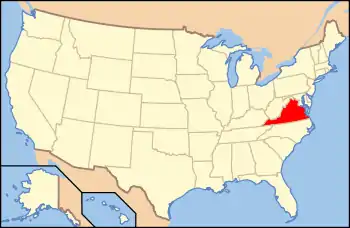The Pentagon
The Pentagon is the headquarters building of the United States Department of Defense. As a symbol of the U.S. military, the phrase The Pentagon is also often used as a metonym or synecdoche for the Department of Defense and its leadership.
| The Pentagon | |
|---|---|
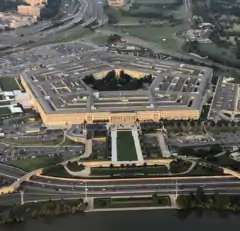 Aerial view in 2018 from Potomac River | |
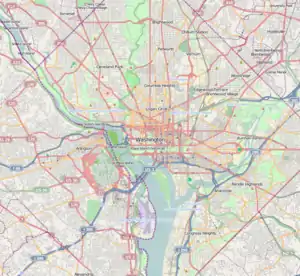 Location in the Washington, D.C. area | |
| General information | |
| Status | Complete |
| Architectural style | Stripped Classicism |
| Location | Arlington County, Virginia |
| Address | 1400 Defense Pentagon, Washington, D.C. |
| Coordinates | 38°52′15″N 77°03′19″W |
| Construction started | 11 September 1941 |
| Completed | 15 January 1943 |
| Cost | $83 million (equivalent to $1.13 billion in 2019)[1] |
| Owner | Department of Defense |
| Height | |
| Roof | 71 feet (22 m)[2] |
| Top floor | 5 |
| Technical details | |
| Floor count | 7 |
| Floor area | 6,636,360 square feet (620,000 m2) |
| Design and construction | |
| Architect | George Bergstrom David J. Witmer |
| Main contractor | John McShain, Inc. |
| Other information | |
| Parking | 67 acres (27 ha) |
| References | |
Pentagon Office Building Complex | |
  | |
| Location | Jefferson Davis Hwy./VA 110 at I-395, Arlington, Virginia |
| Area | 34 acres (14 ha)[3] |
| Built | 1941 |
| Architect | Bergstrom, G.E.; Witmer, D.J. |
| Architectural style | Classical Revival, Modern Movement, Stripped Classicism |
| NRHP reference No. | 89000932[4] |
| VLR No. | 000-0072 |
| Significant dates | |
| Added to NRHP | 27 July 1988 |
| Designated VLR | 18 April 1989[5] |
Located in Arlington County, Virginia, across the Potomac River from Washington, D.C., the building was designed by American architect George Bergstrom and built by contractor John McShain. Ground was broken on 11 September 1941, and the building was dedicated on 15 January 1943. General Brehon Somervell provided the major motivating power behind the project;[6] Colonel Leslie Groves was responsible for overseeing the project for the U.S. Army.
The Pentagon is the world's largest office building, with about 6,500,000 square feet (150 acres; 0.60 km2) of floor space, of which 3,700,000 sq ft (85 acres; 0.34 km2) are used as offices.[7][8] Some 23,000 military and civilian employees,[8] and another 3,000 non-defense support personnel, work in the Pentagon. It has five sides, five floors above ground, two basement levels, and five ring corridors per floor with a total of 17.5 miles (28.2 km)[8] of corridors. The central five-acre (2.0 ha) pentagonal plaza is nicknamed "ground zero" on the presumption that it would be a prime target in a nuclear war.[9]
On 11 September 2001, American Airlines Flight 77 was hijacked and flown into the western side of the building, killing 189 people. Of those killed, 64 were on the hijacked airplane, and 125 were in the Pentagon.[10] It was the first significant foreign attack on Washington's governmental facilities since the city was burned by the British during the War of 1812.
The Pentagon is listed on the National Register of Historic Places and is a National Historic Landmark.[4]
Layout and facilities

The Pentagon building spans 28.7 acres (116,000 m2), and includes an additional 5.1 acres (21,000 m2) as a central courtyard.[11]
Starting with the north side and moving clockwise, its five façade entrances are the Mall Terrace, the River Terrace, the Concourse (or Metro Station), the South Parking, and the Heliport.[12] On the north side of the building, the Mall Entrance, which also features a portico, leads out to a 600-foot-long (180 m) terrace that is used for ceremonies. The River Entrance, which features a portico projecting out twenty feet (6 m), is on the northeast side, overlooking the lagoon and facing Washington. A stepped terrace on the River Entrance leads down to the lagoon; and a landing dock was used until the late 1960s to ferry personnel between Bolling Air Force Base and the Pentagon.[11] The main entrance for visitors is on the southeast side, as are the Pentagon Metro station and the bus station.
There is also a concourse on the southeast side of the second floor of the building, which contains a mini-shopping mall. The south parking lot adjoins the southwest facade, and the west side of the Pentagon faces Washington Boulevard.
The concentric rings are designated from the center out as "A" through "E" (with additional "F" and "G" rings in the basement). "E" Ring offices are the only ones with outside views and are generally occupied by senior officials. Office numbers go clockwise around each of the rings, and have two parts: a nearest-corridor number (1 to 10), followed by a bay number (00 to 99), so office numbers range from 100 to 1099. These corridors radiate out from the central courtyard, with corridor 1 beginning with the Concourse's south end. Each numbered radial corridor intersects with the corresponding numbered group of offices (for example, corridor 5 divides the 500 series office block). There are a number of historical displays in the building, particularly in the "A" and "E" rings.
Subterranean floors in the Pentagon are lettered "B" for Basement and "M" for Mezzanine. The concourse is on the second floor at the Metro entrance. Above ground floors are numbered 1 to 5. Room numbers are given as the floor, concentric ring, and office number (which is in turn the nearest corridor number followed by the bay number). Thus, office 2B315 is on the second floor, B ring, and nearest to corridor 3 (between corridors 2 and 3). One way to get to this office would be to go to the second floor, get to the A (innermost) ring, go to and take corridor 3, and then turn left on ring B to get to bay 15.[13]
It is possible for a person to walk between any two points in the Pentagon in less than ten minutes.[14] [15] The complex includes eating and exercise facilities, and meditation and prayer rooms.
Just south of the Pentagon are Pentagon City and Crystal City, extensive shopping, business, and high-density residential districts in Arlington. Arlington National Cemetery is to the north. The Pentagon is surrounded by the relatively complex Pentagon road network.[16]
The Pentagon has six Washington, DC, ZIP Codes (despite its location in Virginia): The Secretary of Defense, the Joint Chiefs of Staff, and the four service branches each have their own ZIP Code.[17]
As of July 2020, Pentagon tours were suspended due to the COVID-19 pandemic.[18]

History
Background

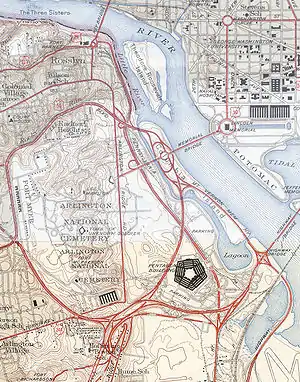
Before the Pentagon was built, the United States Department of War was headquartered in the Munitions Building, a temporary structure erected during World War I along Constitution Avenue on the National Mall. The War Department, which was a civilian agency created to administer the U.S. Army, was spread out in additional temporary buildings on the National Mall, as well as dozens of other buildings in Washington, D.C., Maryland and Virginia. In the late 1930s, a new War Department Building was constructed at 21st and C Streets in Foggy Bottom but, upon completion, the new building did not solve the department's space problem and ended up being used by the Department of State.[19] When World War II broke out in Europe, the War Department rapidly expanded in anticipation that the United States would be drawn into the conflict. Secretary of War Henry L. Stimson found the situation unacceptable, with the Munitions Building overcrowded and the department spread out.[20][21]
Stimson told U.S. President Franklin D. Roosevelt in May 1941 that the War Department needed additional space. On 17 July 1941, a congressional hearing took place, organized by Virginia congressman Clifton Woodrum, regarding proposals for new War Department buildings. Woodrum pressed Brigadier General Eugene Reybold, who was representing the War Department at the hearing, for an "overall solution" to the department's "space problem" rather than building yet more temporary buildings. Reybold agreed to report back to the congressman within five days. The War Department called upon its construction chief, General Brehon Somervell, to come up with a plan.[22]
Planning
Government officials agreed that the War Department building, officially designated Federal Office Building No 1, should be constructed across the Potomac River, in Arlington County, Virginia. Requirements for the new building were that it be no more than four stories tall, and that it use a minimal amount of steel. The requirements meant that, instead of rising vertically, the building would be sprawling over a large area. Possible sites for the building included the Department of Agriculture's Arlington Experimental Farm, adjacent to Arlington National Cemetery, and the obsolete Hoover Field site.[23]
The site originally chosen was Arlington Farms, which had a roughly pentagonal shape, so the building was planned accordingly as an irregular pentagon.[24] Concerned that the new building could obstruct the view of Washington, D.C., from Arlington Cemetery, President Roosevelt ended up selecting the Hoover Airport site instead.[25] The building retained its pentagonal layout because a major redesign at that stage would have been costly, and Roosevelt liked the design. Freed of the constraints of the asymmetric Arlington Farms site, it was modified into a regular pentagon, which resembled the fortifications of the gunpowder age.[26]
On 28 July, Congress authorized funding for a new Department of War building in Arlington, which would house the entire department under one roof,[27] and President Roosevelt officially approved of the Hoover Airport site on 2 September.[28] While the project went through the approval process in late July 1941, Somervell selected the contractors, including John McShain, Inc. of Philadelphia, which had built Washington National Airport in Arlington, the Jefferson Memorial in Washington, and the National Naval Medical Center in Bethesda, Maryland, along with Wise Contracting Company, Inc. and Doyle and Russell, both from Virginia.[29] In addition to the Hoover Airport site and other government-owned land, construction of the Pentagon required an additional 287 acres (1.16 km2), which were acquired at a cost of $2.2 million (equivalent to $29.9 million in 2019[1]).[30] The Hell's Bottom neighborhood, consisting of numerous pawnshops, factories, approximately 150 homes, and other buildings around Columbia Pike, was also cleared to make way for the Pentagon.[31] Later, 300 acres (1.2 km2) of land were transferred to Arlington National Cemetery and to Fort Myer, leaving 280 acres (1.1 km2) for the Pentagon.[30]
Construction
Contracts totaling $31,100,000 (equivalent to $423 million in 2019[1]) were finalized with McShain and the other contractors on 11 September, and ground was broken for the Pentagon the same day.[32] Among the design requirements, Somervell required the structural design to accommodate floor loads of up to 150 pounds per square inch (1,000 kPa), which was done in case the building became a records storage facility at some time after the end of the current war.[28] A minimal amount of steel was used as it was in short supply during World War II. Instead, the Pentagon was built as a reinforced concrete structure, using 680,000 tons of sand dredged from the Potomac River, and a lagoon was created beneath the Pentagon's river entrance.[33] To minimize steel usage, concrete ramps were built rather than installing elevators.[34][35] Indiana limestone was used for the building's façade.[36]
Architectural and structural design work for the Pentagon proceeded simultaneously with construction, with initial drawings provided in early October 1941, and most of the design work completed by 1 June 1942. At times the construction work got ahead of the design, with different materials used than specified in the plans. Pressure to speed up design and construction intensified after the attack on Pearl Harbor on 7 December 1941, with Somervell demanding that 1,000,000 sq ft (9.3 ha) of space at the Pentagon be available for occupation by 1 April 1943.[37] David J. Witmer replaced Bergstrom as chief architect on 11 April after Bergstrom resigned due to charges, unrelated to the Pentagon project, of improper conduct while he was president of the American Institute of Architects.[38] Construction was completed 15 January 1943.[39]
Soil conditions of the site – on the Potomac River floodplain – presented challenges, as did the varying elevations across the site, which ranged from ten to forty feet (3 to 12 m) above sea level. Two retaining walls were built to compensate for the elevation variations, and cast-in-place piles were used to deal with the soil conditions.[40] Construction of the Pentagon was completed in approximately 16 months at a total cost of $83 million (equivalent to $1.13 billion in 2019[1]). The building's approximate height is 71 feet (22 m), and each of the five sides is 921 feet (281 m) in length.[2]
The building was built one wing at a time; each wing was occupied as soon as it was completed, even as construction continued on the remaining wings.
The Pentagon was designed in accordance with the racial segregation laws in force in the state of Virginia at the time, with separate eating and lavatory accommodations for white and black persons; the sets of lavatories were side by side, and the dining areas for black persons were in the basement.[41][42] However, when Roosevelt visited the facility before its dedication, he ordered removal of the "Whites Only" signs, and the Pentagon became the only building in Virginia where segregation laws (which remained in force until 1965) were not enforced. The side by side sets of restrooms still exist, but are used by all.[42]
Incidents
Protests
The Pentagon became a focal point for protests against the Vietnam War during the late 1960s. A group of 2,500 women, organized by Women Strike for Peace, demonstrated outside of Secretary of Defense Robert S. McNamara's office at the Pentagon on 15 February 1967.[43] In May 1967, a group of 20 demonstrators held a sit-in outside the Joint Chiefs of Staff's office, which lasted four days before they were arrested.[44] In one of the better known incidents, on 21 October 1967, some 35,000 anti-war protesters organized by the National Mobilization Committee to End the War in Vietnam, gathered for a demonstration at the Defense Department (the "March on the Pentagon"), where they were confronted by some 2,500 armed soldiers. During the protest, a famous picture was taken, where George Harris placed carnations into the soldiers' gun barrels.[45] The march concluded with an attempt to "exorcise" the building.[46]
On 19 May 1972, the Weather Underground Organization bombed a fourth-floor women's restroom, in "retaliation" for the Nixon administration's bombing of Hanoi in the final stages of the Vietnam War.[47]
On 17 March 2007, 4,000 to 15,000 people (estimates vary significantly) protested the Iraq War[48] by marching from the Lincoln Memorial to the Pentagon's north parking lot.
Renovation
From 1998 to 2011, the Pentagon was completely gutted and reconstructed in phases to bring it up to modern standards and improve security and efficiency. Asbestos was removed and all office windows sealed.[49]
As originally built, most Pentagon office space consisted of open bays which spanned an entire ring. These offices used cross-ventilation from operable windows instead of air conditioning for cooling. Gradually, bays were subdivided into private offices with many using window air conditioning units. With renovations now complete, the new space includes a return to open office bays, a new Universal Space Plan of standardized office furniture and partitions developed by Studios Architecture.[50]
11 September 2001 attacks
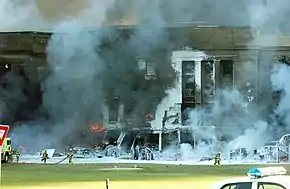
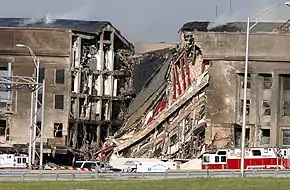
On 11 September 2001, coincidentally the 60th anniversary of the Pentagon's groundbreaking, five al-Qaeda affiliated hijackers took control of American Airlines Flight 77, en route from Washington Dulles International Airport to Los Angeles International Airport, and deliberately crashed the Boeing 757 airliner into the western side of the Pentagon at 9:37 am EDT as part of the September 11, 2001 attacks. The impact of the plane severely damaged the outer ring of one wing of the building and caused its partial collapse.[51] At the time of the attacks, the Pentagon was under renovation and many offices were unoccupied, resulting in fewer casualties. Only 800 of 4,500 people who would have been in the area were there because of the work. Furthermore, the area hit, on the side of the Heliport facade, was the section best prepared for such an attack. The renovation there, improvements which resulted from the Oklahoma City bombing, had nearly been completed.[52][12][53]
It was the only area of the Pentagon with a sprinkler system, and it had been reconstructed with a web of steel columns and bars to withstand bomb blasts. The steel reinforcement, bolted together to form a continuous structure through all of the Pentagon's five floors, kept that section of the building from collapsing for 30 minutes—enough time for hundreds of people to crawl out to safety. The area struck by the plane also had blast-resistant windows—2 inches thick and 2,500 pounds each—that stayed intact during the crash and fire. It had fire doors that opened automatically and newly built exits that allowed people to get out.[53]
Contractors already involved with the renovation were given the added task of rebuilding the sections damaged in the attacks. This additional project was named the "Phoenix Project," and was charged with having the outermost offices of the damaged section occupied by 11 September 2002.[54][55][56]
When the damaged section of the Pentagon was repaired, a small indoor memorial and chapel were added at the point of impact. For the fifth anniversary of the 11 September 2001 attacks, a memorial of 184 beams of light shone up from the center courtyard of the Pentagon, one light for each victim of the attack. In addition, an American flag is hung each year on the side of the Pentagon damaged in the attacks, and the side of the building is illuminated at night with blue lights. After the attacks, plans were developed for an outdoor memorial, with construction underway in 2006. This Pentagon Memorial consists of a park on 2 acres (8,100 m2) of land, containing 184 benches, one dedicated to each victim. The benches are aligned along the line of Flight 77 according to the victims' ages, from 3 to 71. The park opened to the public on 11 September 2008.[57][58][59]
Hall of Heroes

On the building's main concourse is the Hall of Heroes, opened 1968[60] and dedicated to the more than 3,460 recipients of the Medal of Honor, the United States' highest military decoration.[61][62][63][note 1][66][67] The three versions of the Medal of Honor – Army, Sea Service (for the Marine Corps, Navy, and Coast Guard), and Air Force – are on display along with the names of recipients.[66] The Hall is also used for promotions, retirements, and other ceremonies.[68][69][70][71][72]
Gallery
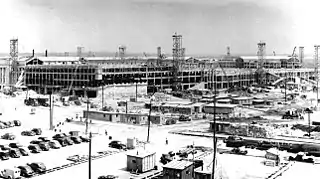 View from northwest with construction underway, July 1942
View from northwest with construction underway, July 1942 Military police keep back Vietnam War protesters during their sit-in on 21 October 1967, at the mall entrance to the Pentagon
Military police keep back Vietnam War protesters during their sit-in on 21 October 1967, at the mall entrance to the Pentagon Aftermath of 9-11 attacks
Aftermath of 9-11 attacks 9/11 anniversary illumination, 2007
9/11 anniversary illumination, 2007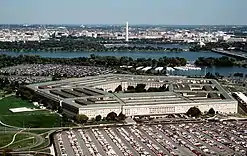 Southwesterly view (1998) with the Potomac River and Washington Monument in background
Southwesterly view (1998) with the Potomac River and Washington Monument in background
See also
Notes
- The Congressional Medal of Honor Society is so designated because that was the name it was given in an act of Congress that was signed into law by US President Dwight D. Eisenhower on 5 August 1958 as Title 36, Chapter 33 of the U.S. Code.[64] The law authorizing the society has since been transferred to Title 36, Chapter 405 of the U.S. Code.[65]
References
- Thomas, Ryland; Williamson, Samuel H. (2020). "What Was the U.S. GDP Then?". MeasuringWorth. Retrieved 22 September 2020. United States Gross Domestic Product deflator figures follow the Measuring Worth series.
- "Facts: Navigating The Pentagon". pentagontours.osd.mil. Retrieved 10 January 2018.
- https://www.livescience.com/23020-pentagon.html |The Pentagon
- "National Register Information System". National Register of Historic Places. National Park Service. 9 July 2010.
- "Virginia Landmarks Register". Virginia Department of Historic Resources. Archived from the original on 21 September 2013. Retrieved 12 May 2013.
- Vogel, Steve (2007). The Pentagon – A History: The Untold Story of the Wartime Race to Build the Pentagon and to Restore it Sixty Years Later. Random House. ISBN 978-0-8129-7325-9.
- "The Pentagon – George Bergstrom – Great Buildings Online". Greatbuildings.com. Archived from the original on 15 October 2008. Retrieved 26 October 2008.
- "The Pentagon, Facts & Figures". Archived from the original on 19 August 2014. Retrieved 23 August 2014.
- "Pentagon Hot Dog Stand, Cold War Legend, to be Torn Down". United States Department of Defense. 20 September 2006. Retrieved 6 May 2010.
'It's rumored that a portion of their (Soviet) nuclear arsenal was directed at that building, the Pentagon hot dog stand,' tour guides tell visitors as they pass the stand. 'This is where the building earned the nickname Cafe Ground Zero, the deadliest hot dog stand in the world.'
- "Pentagon Memorial Dedication". DefenseLink.mil. Retrieved 27 May 2009.
- Goldberg, Alfred (1992). The Pentagon: The First Fifty Years. Office of the Secretary of Defense / Government Printing Office. p. 57. ISBN 0-16-037979-2.
- "The Pentagon". globalsecurity.org. Retrieved 25 February 2010.
- "How to Find a Room in the Pentagon". Headquarters, Dept. of the Army. Archived from the original on 21 September 2007. Retrieved 13 September 2007.
- "9 Things You May Not Know About the Pentagon". History.com. 24 September 2019. Retrieved 30 January 2021.
- "Man shoots 2 officers outside Pentagon". CNN. 5 March 2010. Retrieved 25 May 2010.
- "Mixing Bowl Interchange Complex". roadstothefuture.com. Retrieved 22 November 2006.
- "Facts & Figures: Zip Codes". Archived from the original on 19 August 2014.
- Coleman, Justine. "White House, Pentagon shutting down tours amid coronavirus outbreak". The Hill. Retrieved 20 July 2020.
- Goldberg (1992), pp. 6–9.
- "Intro – Secretaries of War and Secretaries of the Army". United States Army Center of Military History. 1992.
- "Main Navy & Munitions Buildings". Naval History & Heritage Command. Archived from the original on 5 October 2001. Retrieved 17 October 2008.
- Vogel (2007), pp. 29–33.
- Vogel (2007), pp. 35–37.
- "Bureau of Public Roads memorandum". 25 October 1960.
- "General Information". Archived from the original on 29 November 2005. Retrieved 4 December 2005.
- Vogel, Steve (27 May 2007). "How the Pentagon Got Its Shape". The Washington Post. p. W16. Retrieved 26 May 2007.
- Goldberg (1992), p. 22.
- Goldberg (1992), p. 33.
- Goldberg (1992), p. 29.
- Goldberg (1992), p. 34.
- Vogel (2007), p. 131
- Goldberg (1992), pp. 35, 44.
- "Rare, Unseen: Building the Pentagon". Life. Archived from the original on 26 September 2011.
- McGrath, Amanda (26 May 2007). "How The Pentagon Got Its Shape (Gallery)". The Washington Post.
- Goldberg (1992), pp. 52–53
- Owens, Jim (February 2005). "Replacing the stone and rebuilding the Pentagon". Mining Engineering. 57 (2): 21–26.
- Goldberg (1992), pp. 39–42.
- Goldberg (1992), p. 36
- "Construction to Completion". The Pentagon Tours. United States Department of Defense. Archived from the original on 3 April 2016. Retrieved 20 July 2016.
- Goldberg (1992), pp. 47, 52
- Weyeneth, Robert R. (2005). The Architecture of Racial Segregation: The Challenges of Preserving the Problematical Past. pp. 28–30.
- Carroll, James (2007). House of War: The Pentagon and the Disastrous Rise of American Power. Mariner Books. pp. 4–5. ISBN 978-0-618-18780-5.
- White, Jean M. (16 February 1967). "2500 Women Storm Pentagon Over War". Washington Post.
- Auerbach, Stuart (13 May 1967). "Pentagon Protesters Jailed". Washington Post.
- "Flowers, Guns and an Iconic Snapshot". The Washington Post. 18 March 2007. Retrieved 25 May 2010.
- Alexander, David (2008). The Building: A Biography of the Pentagon. Voyageur Press. p. 192. ISBN 9780760320877.
- Jacobs, Ron (1997). The Way the Wind Blew. Verso. p. 142. ISBN 1-85984-167-8.
- "8 Years After Start of War, Anger Reigns". The Washington Post. 17 March 2007. p. A1.
- Vogel, Steve (22 June 2011). "New Pentagon Is A Paragon". The Washington Post. p. 1.
- "Renovation of the Pentagon". Archived from the original on 4 October 2006. Retrieved 9 October 2006.
- Isikoff, Michael; Daniel Klaidman (10 June 2002). "The Hijackers We Let Escape". Newsweek. Retrieved 22 October 2009.
- Schrader, Esther (16 September 2001). "Pentagon, a Vulnerable Building, Was Hit in Least Vulnerable Spot". Los Angeles Times. Retrieved 25 February 2010.
- "Where The Pentagon Was Hit". LA Times. Retrieved 21 June 2015.
- "Pentagon Renovation Program". Archived from the original on 8 May 2006. Retrieved 4 December 2005.
- Childs, Nick (15 August 2002). "Americas: Pentagon staff reclaim destroyed offices". BBC News. Retrieved 4 December 2005.
- "Pentagon History – September 11, 2001". Pentagon.osd.mil. Archived from the original on 26 September 2011. Retrieved 26 October 2008.
- "Pentagon Memorial". Archived from the original on 9 January 2009.
- "Contractor Selected for the Pentagon Memorial" (Press release). United States Department of Defense. 6 August 2003. 576-03. Archived from the original on 11 May 2006.
- Wilgoren, Debbie; Miroff, Nick; Shulman, Robin (11 September 2008). "Pentagon Memorial Dedicated on 7th Anniversary of Attacks". The Washington Post. Retrieved 11 September 2008.
- Maffre, John (15 May 1968). "The President Looks to Peace 'For Which These Men...Have Fought...'". The Washington Post. p. 1.
- Department of the Army (1 July 2002). "Section 578.4 Medal of Honor". Code of Federal Regulations. Government Printing Office. Title 32, Volume 2. Retrieved 14 March 2012.
- DoD Award Manual, 23 November 2010, 1348. 33, P. 31, 8. c. (1) (a)
- Tucker, Spencer C.; Arnold, James; Wiener, Roberta (2011). The Encyclopedia of North American Indian Wars, 1607–1890: A Political, Social, and Military History. ABC-CLIO. p. 879. ISBN 978-1-85109-697-8. Retrieved 14 March 2012.
- "The Congressional Medal of Honor Society's History". Official Site. Congressional Medal of Honor Society. Retrieved 1 October 2006.
- Welcome to the Headquarters Department of Defense: Self Guided Tour Brochure – Pentagon Tours Program. Retrieved 2 December 2013.
- Baker, Henderson. "Inside the Pentagon Post 9/11". Scholastic News Online. Retrieved 2 December 2013.
- Hirschfelder, Paulette (2012). The Extraordinary Book of Native American Lists. Lanham, Maryland: Scarecrow Press. p. 220.
- Roth, S. (23 June 2000). "Pentagon's Hall of Heroes Welcomes Asian-American Veterans". Gannett News Service. Retrieved 1 December 2013.
- Staff writer (30 March 1991). "Pentagon's Gulf War Spokesman Retires". St.Petersburg Times. Retrieved 1 December 2013.
- Omicinski, J. (1 December 1999). "Comanche Code-Talkers Honored for WWII Service". Gannett News Service. Retrieved 3 December 2013.
- Staff writer (26 February 2004). "Readiness Award". The Charleston Gazette. Retrieved 2 December 2013.
- "Flight 77, Video 2". Judicial Watch. Archived from the original on 16 November 2006.
External links
| Wikimedia Commons has media related to The Pentagon. |
- The Pentagon website
- Popular Mechanics, March 1943, "Army's Giant Five-by-Five" one of earliest World War II articles on the Pentagon
- Pentagon Force Protection Agency
- How the Pentagon Got Its Shape – The Washington Post, 26 May 2007
- U.S. Geological Survey Geographic Names Information System: The Pentagon




